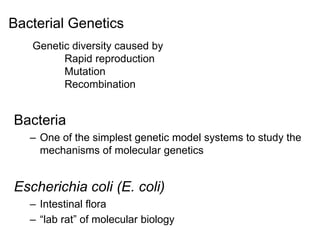Bacteria such as E. coli are useful models for studying genetics due to their simple genetic systems and rapid reproduction. Their DNA is organized into a single circular chromosome as well as optional extrachromosomal elements like plasmids. Bacterial genomes differ from eukaryotes in that they lack introns. Genetic diversity in bacteria arises from high mutation rates due to rapid growth and horizontal gene transfer mechanisms like transduction, transformation, and conjugation. Transduction involves the transfer of bacterial genes by bacteriophages. Transformation is the uptake of naked DNA from the environment, while conjugation is direct DNA transfer between joined bacterial cells mediated by plasmids like the F factor.
































